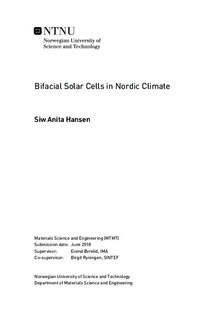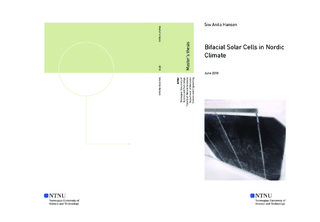| dc.description.abstract | Bifacial solar cells can be the new trend within photovoltaic (PV) technology. They have the ability to take advantage of not only the direct irradiance from the sunlight, but also the indirect light which is reflected by the surroundings (albedo effect). This is due to the innovative design of a bifacial solar cell, by which can absorb light from both front and rear side of the cell, simultaneously, which again can increase the efficiency output of the cell. By use of a material of highly reflective characteristic surrounding the cells, this efficiency output can be increased even more. Bifacial solar cells offer a promising possibility to reduce the levelized cost of energy (LCOE) for many PV applications, and have numerous of different installation options.
The concept of bifacial solar cells is not new, it has been described earlier in the scientific literature by Luque et al. (1980)(1) as a new concept for improving the energy output of photovoltaic (PV) systems, and it has been investigated since the 1960s(2). A module of bifacial solar cells can achieve a higher efficiency output on a smaller space, than what a module of monofacial solar cells can do, and hence fewer bifacial cells are needed to achieve the same output as with monofacial cells. Thereby, bifacial solar cells can be seen as more environment-friendly then that of monofacial solar cells.
In this study the effect of the Nordic climate on a bifacial solar cell was studied. This climate is characterized by relatively low temperatures and cold weather. Snow, temperature and rime ice were parameters that were tested for on the solar cell. Different tilt angles on the bifacial solar cell were studied. In addition, it was investigated how the reflection material underneath the cell affected the efficiency output of the bifacial cell.
The bifacial solar cell that was used in this study is a Zebra cell and is made of a 156x156 mm2 n-type Czochralski (Cz) silicon wafer. The solar cell was placed in a stand along with an ISET sensor connected to a data logger, which measured the irradiance and temperature on the cell. The experiment was performed inside a chamber with a LED lamp, as well as outside with the sun as the light source.
Based on the results, the Nordic climate seem to have the ability to increase the efficiency output of bifacial solar cells, due to the low temperatures that are present, and by which have a positive affect on the conver- sion of the incident radiation into electricity. Rime ice on the cell has also shown, interestingly enough, good results. The tilt angle on the bifacial solar cells, is to a large degree dependent on the position to where the cells are mounted according to the sunlight. Based on the reflection material that was tested for, paper with a scale of colours ranging from white to dark, white and black colour - the two extremes - were proven to give the highest and lowest output of the solar cell, respectively. | |

